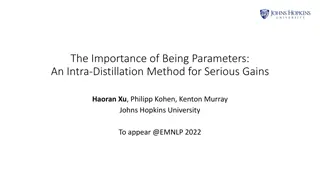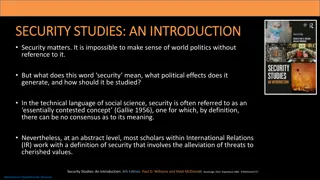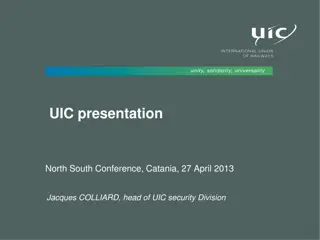Enhancing Security with Efficient Intra-App Compartmentalization
Thwart memory disclosure attacks using SeCage, a hypervisor-enforced intra-app compartment solution. Achieve strong isolation to prevent secret data exposure across large attack surfaces. Implement practical and efficient measures to protect against vulnerabilities like Heartbleed and rootkits with minimal performance impact.
Download Presentation

Please find below an Image/Link to download the presentation.
The content on the website is provided AS IS for your information and personal use only. It may not be sold, licensed, or shared on other websites without obtaining consent from the author. Download presentation by click this link. If you encounter any issues during the download, it is possible that the publisher has removed the file from their server.
E N D
Presentation Transcript
Institute of Parallel and Distributed Systems CCS 2015 IPADS Thwarting Memory Disclosure with Efficient Hypervisor-enforced Intra-domain Isolation Yutao Liu, Tianyu Zhou, Kexin Chen, Haibo Chen, Yubin Xia Institute of Parallel and Distributed System (IPADS) Shanghai Jiao Tong University http://ipads.se.sjtu.edu.cn
HeartBleed Attack Intra-app memory disclosure attack One over-read bug discloses the whole memory data 010000100001 110100001001 001001010priv atekeys101100 111100010pass word00101111 0010000111110 Heartbeat msg Memory Over-read bug Arbitrary memory data Attackers Affect over 60% of websites Attackers can steal private keys and user accounts
Memory Disclosure Vuls are Prevalent CVEs summary (2000 ~ 2015) 0 50 100 150 200 Improper error handling Improper null terminator Invalid pointer Plaintext in memory Application Kernel Off-by-one vulns Others Out-of-bound read Uninitialized memory Use-after-free vulns 388 Total It is hard to prevent all of these bugs
Large Attack Surface for Secret Disclosure Process Isolation Web Server Process Private Keys Web Other Processes Libraries Intra-application attack Operating System Cross-ring attack Kernel-level attack Rootkit Secret Attack Vulnerabilities
Compartmentalization to the Rescue Main problem: All data reside in the same region Attackers can read memory of the compromised process Rootkit can read memory of the whole system One potential solution: compartmentalization Create specific compartment for the critical data Isolate it from other compartments Issues with prior efforts Cannot protect from malicious kernel Too coarse to prevent intra-app attacks Hard to protect large-scale software
Contribution SeCage: hypervisor-enforced intra-app compartment Strong isolation: prevent from large attack surfaces Practical: hybrid approach to decomposing large-scale software Efficient: leverage commodity hardware features (VMFUNC) to separate policy from invocation to minimize VM traps Evaluation results Apply SeCage to OpenSSL and CryptoLoop Prevent secret disclosure attacks, e.g., heartbleed, rootkit Less than 8% performance overhead for normal use cases
Outline Approach overview Runtime isolation enforcement Application decomposition Implementation and evaluation
Approach Overview Goal: protect secrets from large attack surfaces, yet in a practical and efficient way Compartmentalize critical data and code Use hybrid analysis to extract secret closure Isolate the secret closure from other context Leverage hypervisor to enforce memory isolation Secret compartments reside in different memory regions Illegal secret memory access triggers violation to VMExit
SeCage Architecture Application decomposition Decomposition APP APP CODE S Func Trampoline Life-cycle Management APP DATA DATA Main Compartment Secret Operating System Compartment Runtime Protection Hypervisor Memory Isolation Initialization Hardware Threat model & assumption Trust the hypervisor, not trust OS or other compartments in app Do not consider about DoS and side-channel attacks
Challenges Frequent hypervisor-intervention for VM-based approach Introduce large performance overhead Heavy manual effort for compartmentalization Secrets are used and propagated throughout the lifecycle Require precise and complete closure of secrets
Outline Approach overview Runtime isolation enforcement Application decomposition Implementation and evaluation
Runtime Isolation Enforcement Hypervisor-enforced memory isolation Shadow the secret memory using EPT memory protection Leverage VMFUNC to separate control plane and data plane Securing execution flow with trampoline mechanism Sensitive functions are not self-contained Communication between secret and main compartment should be protected Lifecycle protection of secret compartment
Extended Page Table (EPT) 101 Translate guest physical addr to host physical addr The two-level translation are all done by hardware EPT Host Physical Address (HPA) Guest Physical Address (GPA) Guest Page table Guest Virtual Address (GVA) EPT is manipulated and maintained by hypervisor Hypervisor controls how guest accesses physical address Any EPT violation triggers VMExit to hypervisor
Memory Isolation using EPT Mechanism Leverage EPT mechanism to shadow secret memory Data segment: secret memory is removed from main EPT Code segment: sensitive functions only exist in secret EPT Secret EPT Main EPT Other Data Data Segment Secrets Other Logics Code Segment Sensitive Functions Springboard Trampoline
Problem of EPT protection Context switch introduces large overhead Every EPT switch is intervened by hypervisor VMExit takes much more time than function call Time (ns) 600 544.4 500 400 300 200 100 64.65 3.37 0 Function call System call VM call
VM Function (VMFUNC) 101 VM Functions: Intel virtualization extension Non-root guest VMs can directly invoke some functions without VMExit VM Function 0: EPTP Switching Software in guest VM can directly load a new EPT pointer Time (ns) 600 544.4 400 200 64.65 63.22 3.37 0 Function call System call VM call VMFUNC VMFUNC can provide the hypervisor-level function at the cost of system calls
Using VMFUNC for Efficiency Separate control plane from data plane Control plane (policy): hypervisor pre-configure the EPT used by different compartments 0: Alternate-EPTP 1: Alternate-EPTP Configure EPTP_LIST_ADDR Set VMCS control bits 511: Alternate-EPTP Data plane (invocation): application can directly switch EPT without hypervisor intervention EPTP Switching invocation: VMFUNC opcode (EAX = 0, ECX = EPTP_index)
Security Problem of VMFUNC What if attackers directly switch EPT? Since EPT switching is not checked by hypervisor Recall: the code segment of the secret compartment It only contains trusted sensitive functions The legal entrances to the secret compartment are fixed Invalid VMFUNC invocation causes EPT violation Other Logics Code Segment Sensitive Functions Springboard Trampoline
Runtime Isolation Enforcement Hypervisor-enforced memory isolation Shadow the secret memory using EPT memory protection Leverage VMFUNC to separate control plane and data plane Securing execution flow with trampoline mechanism Sensitive functions are not self-contained Communication between secret and main compartment should be protected Lifecycle protection of secret compartment
Secret Compartment is Not Self-contained Main compartment may invoke sensitive functions main secret compartment compartment Trampoline Secret compartment may invoke normal functions E.g., system call,library call, etc. main secret compartment compartment Springboard Different compartments have different context We use trampoline and springboard to switch the context
Use VMFUNC to Secure Execution Flow Trampoline control flow Trampoline Trampoline s_func() real_s_func() s_func() main secret main Context Switch Context Switch compartment compartment compartment Springboard control flow Springboard Springboard lib_call() real_lib_call() lib_call() secret main secret Context Switch Context Switch compartment compartment compartment Contextswitch is done using VMFUNC
Runtime Isolation Enforcement Hypervisor-enforced memory isolation Shadow the secret memory using EPT memory protection Leverage VMFUNC to separate control plane and data plane Securing execution flow with trampoline mechanism Sensitive functions are not self-contained Communication between secret and main compartment should be protected Lifecycle protection of secret compartment
Example: Lifecycle of Web Server App Private key is involved in the lifecycle of web server Creation: private key is stored in the configuration file Deployment: private key is loaded into memory Execution: private key is propagated and used during runtime Termination: private key is required to be cleared SeCage divides the lifecycle into 5 stages SeCage-RESTORE Pre-LOAD App-LOAD SeCage-INIT RUNTIME Time Deployment Execution Termination Creation
Lifecycle Protection 3 new hypercalls to manipulate secret compartment Initialize and terminate secret compartment Load secrets to memory Ensure secrets never flow to other compartments Guest VM in Secret EPT Guest VM in Main EPT No Secret No Secret SeCage-RESTORE Pre-LOAD App-LOAD SeCage-INIT RUNTIME Time Deployment Execution Termination Creation SECAGE_INIT SECRET_LOAD SECAGE_RESTORE
Outline Approach overview Runtime isolation enforcement Application decomposition Implementation and evaluation
Challenge: Decompose Large-scale Software Static approach: precision issues like pointer aliasing Lead to significantly larger closure than necessary May introduce larger TCB and worse performance Dynamic approach: completeness issue May introduce large false positive Previous efforts to secure OpenSSL application Either resort to much more simplified version like PolarSSL E.g., TrustVisor[S&P 10], Mimosa [S&P 15] Or use more coarse-grained application decomposition E.g., PrivTrans[security 04], which decouple the whole enc/dec modules
Application Decomposition in SeCage A hybrid approach to decomposing application Dynamic approach to extracting the secret closure Automatic decomposition during compilation time Static approach to getting the complete potential sensitive functions, used to avoid corner case during runtime Application Dynamic Closure Extraction Static Taint Analysis Potential Sensitive Functions Main Logic Secret Closure Compilation Runtime Check Secret Main Compartment Compartment
Dynamic Closure Extraction Observation: the execution flow of secrets is relatively fixed Goal: get most common but possibly incomplete secret closure Approach: combine mprotect and debug exception More details can be found in the paper
Static Taint Analysis Taint analysis on secret data flow Leverage CIL*to analyse on the intermediate representation of the application Following data flow should be tracked Propagation of secrets through assignment Propagation of secrets through function parameters Propagation of secrets through return values Dereference of secrets * CIL (C Intermediate Language). http://kerneis.github.io/cil/.
Automatic Application Decomposition Leverage CIL to replace {fs} calls with {ft} calls Leverage GCC section attribute to create memory regions Modify linker to separate secrets from the main region
Outline Approach overview Runtime isolation enforcement Application decomposition Implementation and evaluation
Implementation Implemented on Intel Haswell machine Haswell processor with VMFUNC supported 4 cores (8 hardware threads using hyper-threading), 32 GB memory Software environment KVM with Linux 3.13.7 Guest VM with Linux 3.16.1 2 virtual cores and 4 GB memory Application analysis and decomposition CIL framework, OCaml extension, bash script
Usage Scenarios Protecting Nginx from HeartBleed Protect prime numbers (p and q) and private key exponent (d) Protecting OpenSSH from Rootkit Protect private keys of OpenSSH (same as Nginx) Protecting CryptoLoop* from Kernel Memory Disclosure Protect AES cryptographic keys as secrets * CryptoLoop: file system encryption using kernel Crypto API
Security Analysis Secrets exposure elimination Normal OpenSSH Normal Nginx SeCage Nginx SeCage OpenSSH Reduced attack surfaces Small code base in secret compartment 1350 LoCs for OpenSSL and 430 LoCs for CryptoLoop Restrictions in sensitive functions E.g., no I/O operation, etc.
Performance Evaluation Nginx throughput and latency Use ab benchmark Simulate 20 clients N KeepAlive requests X bytes per request OpenSSH latency SSH to the server and execute common Linux commands Average latency overhead: 6 ms (3%) CryptoLoop I/O bandwidth Use fio benchmark with sequential read/write configurations Average slowdown: 4%
Related Efforts Application-level secret isolation E.g., DieHarder[CCS 10], CRYPTON[CCS 13] , Copker[NDSS 14] Vulnerable to the attack surfaces of kernel, e.g., rootkit Hypervisor-based application protection E.g., OverShadow[ASPLOS 08], InkTag[ASPLOS 13] , Terra[SOSP 03] Vulnerable to the intra-process attack, e.g., heartbleed Hardware-based secret protection E.g., TrustVisor[S&P 10], Haven[OSDI 14], Mimosa [S&P 15] Not suitable for existing hardware and large-scale software SeCage can solve all of these problems
Summary Memory disclosure attacks are hard to defend Broad attack surfaces in user level and kernel level (388 CVEs) SeCage: a practical and efficient hypervisor-enforced approach for secret protection Memory compartmentalization with small TCB Efficient mechanism to separate policy from invocation Practical application decomposition for large-scale software A working prototype on KVM with promising result Successfully eliminate secret exposure Small Performance impact
Institute of Parallel and Distributed Systems Thanks IPADS Questions Questions Institute of Parallel And Distributed Systems http://ipads.se.sjtu.edu.cn























